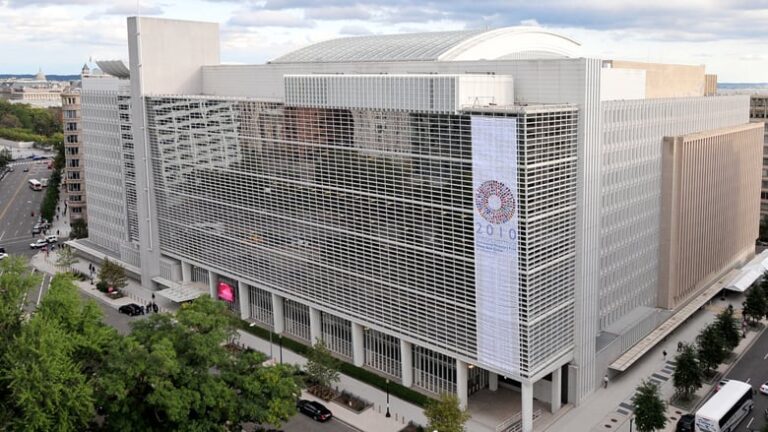The World Bank is a specialized United Nations agency established in 1944 to promote economic development, reduce poverty, and foster shared prosperity in developing countries.
It consists of two distinct entities: the International Development Association (IDA), and the International Bank for Reconstruction and Development (IBRD). The two arms operate under the umbrella of the World Bank Group.
The World Bank is headquartered in Washington, D.C., and is in more than 100 countries worldwide. In this blog post, we will explore the role of the World Bank in world development and its functions in supporting sustainable growth and reducing poverty in developing countries.
Table of Contents
A brief history
The World Bank was established in 1944 at the Bretton Woods Conference in New Hampshire, USA. The conference had representatives from 44 countries who sought to establish a new global economic order following World War II. The Bank was created to provide loans and financial assistance to help rebuild war-torn countries and promote economic development.
Over the years, the World Bank’s goals have evolved to include poverty reduction, social and economic development, and sustainable growth. In the 1960s and 1970s, the Bank focused on promoting economic growth in developing countries. The World Bank accomplished this by providing loans, technical assistance, and developing infrastructure.
In the 1980s and 1990s, the Bank shifted its focus toward poverty reduction and social development. Particularly, the bank focused on improving access to education and healthcare and supporting small businesses.
Recently, the Bank has continued to evolve its goals to meet the changing needs of its member countries. For example, in 2013, it launched the Global Goals initiative, which aims to end extreme poverty by 2030 and promote shared prosperity. The Bank also supports the United Nations Sustainable Development Goals. The aim was to achieve a better and more sustainable future for all.
Structure of the World Bank
The World Bank comprises 190 member countries, each with an equal vote in decision-making. The United States, Japan, China, Germany, France, and the United Kingdom are the largest shareholders.
The organizational structure of the World Bank is complex, with multiple entities and departments. The IBRD provides loans and financial assistance to middle-income countries. In comparison, the International Development Association (IDA) provides grants and interest-free loans to the world’s poorest countries.
The Bank also includes other entities, such as the International Finance Corporation (IFC), which supports private sector development, and the Multilateral Investment Guarantee Agency (MIGA), which provides political risk insurance.
The decision-making process of the World Bank is governed by a Board of Governors with one representative from each member country. The Governors meet once a year to discuss the Bank’s overall strategy and direction. In addition, a Board of Executive Directors comprising 25 directors representing different member countries oversees the Bank’s day-to-day operations. The Board of Executive Directors makes decisions on lending and other operational matters.
Functions of the World Bank
The World Bank has several functions aimed at promoting economic development and reducing poverty in developing countries. Some of these functions include:
- Providing loans and financial assistance: One of the World Bank’s primary functions is to provide loans and financial aid to developing countries. Borrowers can use these loans for various purposes, including infrastructure development, poverty reduction programs, and social services;
- Offering technical assistance: Besides financial aid, the World Bank provides technical assistance to developing countries. This can include training programs for government officials, support for small businesses, and assistance with policy development;
- Conducting research and analysis: The World Bank conducts research and analysis on a wide range of topics related to development, including poverty reduction, economic growth, and social welfare. This research helps to inform the Bank’s lending and technical assistance programs;
- Supporting sustainable development: The World Bank promotes sustainable development in developing countries. This includes supporting programs that promote environmental sustainability, as well as programs that address the social and economic dimensions of sustainability.
Criticisms of the World Bank
Despite its important role in global development, the World Bank has faced criticism from various quarters. Some of the main criticisms include the following:
- Lack of transparency: One of the most significant criticisms is the lack of transparency in its decision-making processes. Critics argue that the Bank is not accountable to the people it serves. They say its operations are often shrouded in secrecy;
- Allegations of promoting neoliberal policies: Some critics argue that the Bank promotes neoliberal policies. They say the bank prioritizes economic growth over social welfare. Critics argue that these policies promote privatization, deregulation, and free trade, which can have negative impacts on workers, communities, and the environment;
- Environmental concerns: The Bank has also faced criticism for its environmental record. Particularly concerning large-scale infrastructure projects such as dams and highways. Critics argue that these projects can have negative impacts on ecosystems and local communities. The Bank should do more to prioritize environmental sustainability.
The World Bank is critical in promoting economic development and reducing poverty in developing countries
The functions of the World Bank include providing loans and financial assistance, offering technical assistance, conducting research and analysis, and supporting sustainable development.
The Bank aims to address the complex and interconnected challenges facing these countries through these efforts. However, the Bank has also faced criticism, including allegations of promoting neoliberal policies, environmental concerns, and lack of transparency.
While the Bank has made efforts to address these concerns, it must continue to listen to its critics. It should work towards greater transparency, accountability, and environmental sustainability. Ultimately, the World Bank has the potential to be a powerful force for good in the world. Its success will depend on its ability to balance its various functions with the needs and aspirations of the people it serves.












